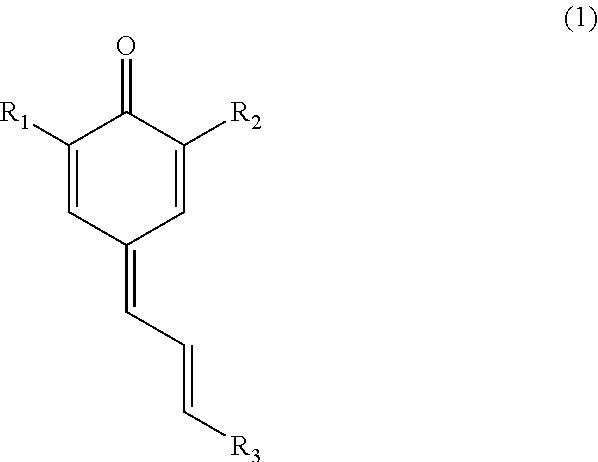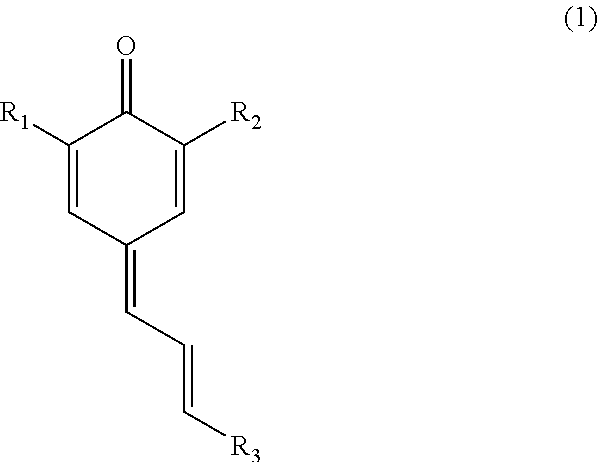Use of quinone methides as antipolymerants for vinylic monomers
a technology of vinyl monomers and methides, which is applied in the field of compounds, can solve the problems of product loss, undesirable thermal polymerization of vinyl monomers, and unsaturated compounds, especially vinyl monomers found in hydrocarbon streams,
- Summary
- Abstract
- Description
- Claims
- Application Information
AI Technical Summary
Benefits of technology
Problems solved by technology
Method used
Image
Examples
example 1
ethod
[0060]2,6-Di-tert-butylphenol (20.192 grams, 96.88 mmoles) and cinnamaldehyde (12.44 mL, 96.88 mmoles) were charged into a 500 mL three-neck round-bottomed flask along with a magnetic follower. The flask was placed on a thermostatted heat block after which the flask was armed with a dropping funnel as well as a Dean-Stark trap and a condenser. A solution of morpholine (8.84 mL, 100 mmoles) in n-heptane (120 mL) was added into the reaction mixture drop wise over 3 hours. To remove water azeotropically, the heating block temperature was set at 145° C. After the addition of the morpholine solution was complete, the reaction was left to progress overnight.
[0061]An aliquot of the reaction mixture was analyzed by GC every two hours until there was no further reduction in the peak height of the 2,6-di-tert-butylphenol was observed. The reaction was cooled to room temperature prior to the addition of the releasing agent. Drop wise, acetic acid anhydride was added to the reaction mixtur...
example 2
ethod
[0064]Into a 500 mL one-neck round-bottomed flask armed with a magnetic follower, 2,6-di-tert-butylphenol (20.602 g: 98.9 mmoles), 20 mL of acetic acid and 50 mL of formic acid were added. The flask was placed in a heating block. After stirring the reaction mixture, cinnamyl alcohol (28.783 g: 98.85 mmoles) was added. The flask was then armed with a water-cooled condenser. The reaction mixture refluxed at 100° C. for 4 hours. Thereafter, the reaction mixture was left to cool down to 25° C. To the flask was added 200 mL of deionized water. The milky solution was then transferred into a separatory funnel. The reaction flask was rinsed with ethyl acetate and the organic washings transferred into the separatory funnel. Additional ethyl acetate was added to the funnel followed by agitation. The aqueous layer was drained off and the organic layer recovered. Anhydrous sodium sulfate was used to dry the ethyl acetate solution. The solvent was removed in vacuo. The resultant crude produ...
example 3
of Cinnamyl Quinone Methide Compounds
[0066]The antipolymerant performance of the isolated cinnamyl quinone methide, 2,6-di-tert-butyl-4-(3-phenylallylidene)cyclohexa-2,5-dienone (7-Cinn-QM), was determined using the static method whereby a 0.31 mM (0.33 mmolal) solution of the retarder was prepared in inhibitor-free styrene. To start with, 4-tert-butylcatechol (TBC) was removed by eluting styrene through alumina. To prepare a 0.31 mM solution of 7-Cinn-QM, 0.0264 g were dissolved in freshly de-inhibited styrene to give a solution of 250 grams. Into twenty-four Ace Glass #15 threaded pressure tubes equipped with PTFE screw caps and fluoroelastomer (FETFE) O-rings, 9 mL of the solution were charged into each tube. To purge as much oxygen out of the solutions as possible, each solution was sparged with nitrogen for 2 minutes. Immediately after sparging each solution, the tube was sealed and the solution kept under a nitrogen gas overhead. In a simulation of the shutdown conditions, the...
PUM
| Property | Measurement | Unit |
|---|---|---|
| temperature | aaaaa | aaaaa |
| boiling point | aaaaa | aaaaa |
| temperature | aaaaa | aaaaa |
Abstract
Description
Claims
Application Information
 Login to View More
Login to View More - R&D
- Intellectual Property
- Life Sciences
- Materials
- Tech Scout
- Unparalleled Data Quality
- Higher Quality Content
- 60% Fewer Hallucinations
Browse by: Latest US Patents, China's latest patents, Technical Efficacy Thesaurus, Application Domain, Technology Topic, Popular Technical Reports.
© 2025 PatSnap. All rights reserved.Legal|Privacy policy|Modern Slavery Act Transparency Statement|Sitemap|About US| Contact US: help@patsnap.com



